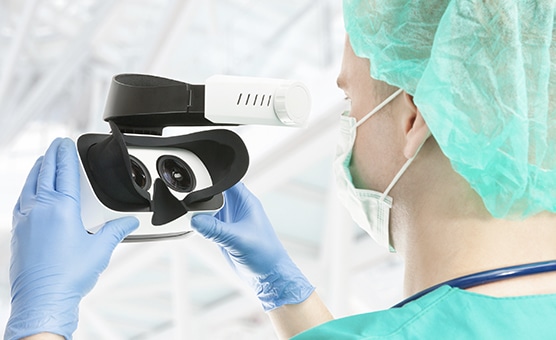Propelling the Future of Healthcare Tech: Technossus’ Quarterly Innovation Project

Propelling the Future of Healthcare Tech: Technossus’ Quarterly Innovation Project
For this quarter’s innovation project, the Technossus team successfully combined two innovative technologies — Google Glass and IBM Watson — to create an intuitive healthcare diagnostics tool.
Using Xamarin tools, we developed a Google Glass app in .NET Framework over the course of one week. We utilized the best parts of Google Glass — hands-free services, the embedded microphone, and Internet connectivity — to transcribe spoken language into text, which was then connected to IBM Watson’s back-end expert healthcare data services. This allowed users wearing Google Glass to get answers to complex medical questions by using nothing more than natural voice queries.
The Inspiration Behind This Project
The idea for this app came from observing how physicians and first responders have used Google Glass and IBM Watson separately to advance the healthcare field. For example, Google Glass has been used for visually guided disaster and mass casualty training, lending support to physicians and first responders in situations in which hand-operated devices were unavailable. This approach is intended to improve users’ performance, decision-making, timing, and education in the field.
IBM’s recent upgrades to Watson created a personalized healthcare resource by adding cloud API and evidence-based learning. Now, Watson can respond to unique inquiries from healthcare professionals or patients and offer possible diagnoses, solutions, home cures, recommended actions, etc. And if integrated into healthcare settings, the system could save time, improve diagnosis accuracy, and provide more up-to-date healthcare information than any individual could retain.
Memorial Sloan Kettering Cancer Center and WellPoint, a private healthcare company, have already begun testing Watson’s diagnostic powers in matters related to lung, prostate, and breast cancers. After teaching Watson millions of pages worth of in-depth, complicated medical information, Watson’s success rate for diagnosing lung cancer was 90 percent — a vast improvement over the 50 percent success rate for human doctors.
The Combined Power of IBM Watson and Google Glass
Our team saw potential in combining these technologies in hopes of assisting medical professionals in a hospital or first responder setting — especially those who don’t always have the time or resources to research medical questions, injuries, or symptoms. Now, with the use of this application, users can ask questions in intense healthcare settings and get answers back from IBM Watson’s extensive internal knowledge base within seconds.
Our hope with this innovation project was to push the boundaries of these technologies and adapt them to be beneficial to healthcare professionals.
By combining the non-intrusive portability of Google Glass with the data-packed intuition of IBM Watson, we were able to create health information technology that can assist healthcare professionals in entirely new ways. And a system like this has the potential to improve patient outcomes, cut costs, reduce treatment times, close the healthcare personnel gap, and increase educational resources.
Technology is playing an exponentially larger role in healthcare and shaking up the major players in healthcare software solutions. That’s why, at Technossus, we’re constantly striving to be one step ahead of everyone else with our projects and products. We’re pushing the boundaries of mobile and cross-platform development in professional and enterprise settings, using both established and emerging technologies in ways that others might not think of.
